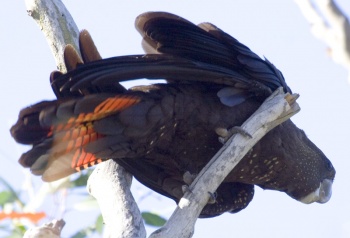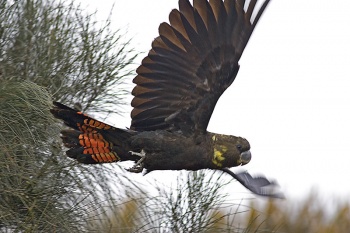Alternative names: Casuarina Cockatoo, Casuarine Cockatoo, Glossy Cockatoo, Latham's Cockatoo, Leach's Black-Cockatoo, Leach's Red-tailed Cockatoo, Nutcracker
- Calyptorhynchus lathami
Identification
46-50 cm (18-20 in) the smallest of the black cockatoos found in Australia
Male
- Mostly black
- Dark brown head
- Red caudal patches
Female
- Duller
- Yellow flecks on the cheeks in breeding birds
- Red barring on the tail.
Distribution
Eastern Australia: Central Eastern Queensland to Gippsland, Victoria and on Kangaroo Island, South Australia
Taxonomy
Subspecies
There are three subspecies of this bird that all occupy specific parts of the continent[1]:
- C. l. erebus which is found in Central North Queensland from Eungella National Park near Mackay south to Monto in South Eastern Queensland.
- C. l. lathami found from Kingaroy and the Wide Bay District of South Eastern Queensland south to East Gippsland in Victoria.
- C. l. halmaturinus found only on Kangaroo Island South Australia
Habitat
All members of this species are sometimes referred to as the "Casuarina Cockatoo" a reference to the bird's preference for eating the cone seeds of the Allocasuarina and Casuarina or She Oak Trees.
Sadly these trees form the greater part of the bird's diet, but are regarded as "rubbish" by most people including developers, who wantonly destroy this habitat. In South Australia, where the birds live solely on Kangaroo Island, recent bushfires have destroyed a large part of the habitat and replanting efforts are continuing.
Conservation Status
In Queensland C.lathami lathami is considered vulnerable and in New South Wales the same status applies.
C.lathami erebus is considered to be safe and maybe even increasing in numbers.
In VictoriaC.lathami lathami is listed as threatened.
The Kangaroo Island population of C.lathami halmaturinis is listed as endangered.
Nationwide, it is believed that less than 18,000 birds may still exist.
Behaviour
Diet
They are a specialist feeder preferring Casuarina seeds over all other foods, however they have been noted feeding on other seed trees.
Breeding
They lay one egg per season and the female stays with the egg until incubation is complete. These birds are dependant on remnant forest for breeding hollows close to water. They appear to form small family groups and seem to move their young away after the first year. The birds are usually cautious but easily approached and will sit feeding on one tree for an entire day. They are easily found when they have their young as the continual calling identifies where they are, however on their own are barely discernable in the casuarinas.
Action
They are fairly poor flyers and appear to "fall" from trees and roosts before taking flight. Spectacular flight displays are sometimes seen when the birds chase each other.
Vocalisation
They have a unique "creaking door" sound to their call.
References
- Clements, J. F., T. S. Schulenberg, M. J. Iliff, S. M. Billerman, T. A. Fredericks, B. L. Sullivan, and C. L. Wood. 2019. The eBird/Clements Checklist of Birds of the World: v2019. Downloaded from http://www.birds.cornell.edu/clementschecklist/download/
- Avibase
- Rowley, I. and P. F. D. Boesman (2020). Glossy Black-Cockatoo (Calyptorhynchus lathami), version 1.0. In Birds of the World (J. del Hoyo, A. Elliott, J. Sargatal, D. A. Christie, and E. de Juana, Editors). Cornell Lab of Ornithology, Ithaca, NY, USA. https://doi.org/10.2173/bow.glbcoc1.01
- BirdForum Member observations
Recommended Citation
- BirdForum Opus contributors. (2025) Glossy Black Cockatoo. In: BirdForum, the forum for wild birds and birding. Retrieved 14 May 2025 from https://www.birdforum.net/opus/Glossy_Black_Cockatoo
External Links
- http://www.glossyblack.org.au = The Glossy Black Conservancy
- http://www.eungella.com.au/Home.html = Information about Eungella N.P.
- http://www.tourkangarooisland.com.au = Information about Kangaroo Island








